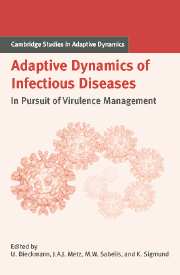Book contents
- Frontmatter
- Contents
- Contributing Authors
- List of Boxes
- Notational Standards
- 1 Introduction
- A Setting the Stage
- B Host Population Structure
- C Within-Host Interactions
- D Pathogen–Host Coevolution
- Introduction to Part D
- 13 Coevolution of Virus and Host Cell-death Signals
- 14 Biogeographical Perspectives on Arms Races
- 15 Major Histocompatibility Complex: Polymorphism from Coevolution
- 16 Virulence Management and Disease Resistance in Diploid Hosts
- 17 Coevolution in Gene-for-gene Systems
- 18 Implications of Sexual Selection for Virulence Management
- 19 Molecular Phylogenies and Virulence Evolution
- E Multilevel Selection
- F Vaccines and Drugs
- G Perspectives for Virulence Management
- References
- Index
- International Institute for Applied Systems Analysis
19 - Molecular Phylogenies and Virulence Evolution
Published online by Cambridge University Press: 15 January 2010
- Frontmatter
- Contents
- Contributing Authors
- List of Boxes
- Notational Standards
- 1 Introduction
- A Setting the Stage
- B Host Population Structure
- C Within-Host Interactions
- D Pathogen–Host Coevolution
- Introduction to Part D
- 13 Coevolution of Virus and Host Cell-death Signals
- 14 Biogeographical Perspectives on Arms Races
- 15 Major Histocompatibility Complex: Polymorphism from Coevolution
- 16 Virulence Management and Disease Resistance in Diploid Hosts
- 17 Coevolution in Gene-for-gene Systems
- 18 Implications of Sexual Selection for Virulence Management
- 19 Molecular Phylogenies and Virulence Evolution
- E Multilevel Selection
- F Vaccines and Drugs
- G Perspectives for Virulence Management
- References
- Index
- International Institute for Applied Systems Analysis
Summary
Introduction
The effective management and prevention of outbreaks of virulent strains of microbes depends on information about when, where, and how such strains arise. In the case of newly emerging human pathogens, this might involve tracing the source of a zoonotic infection to an animal population - such was the case with a hantavirus outbreak in the US state of New Mexico (Nichol et al. 1993). In other cases, an existing, possibly benign, microbe infecting humans or livestock may suddenly give rise to a highly pathogenic (virulent) strain - such was the case with the 1918 “Spanish” flu pandemic. In this second case, information about the mechanism by which virulence arose can provide practical guidance to epidemiologists developing strategies to prevent, or forestall, future epidemics. As well, information about the time and location of origination of virulent strains can inform us about how quarantine measures ought to be applied in the future, or how effective such measures have been in particular instances in the past. In recent years, molecular phylogenies have come to play an increasingly important role in epidemiological studies of microbial pathogens, as they provide information about the location, timing, and mechanisms by which virulent strains arise. In particular, sequences from disease-causing viruses and bacteria that infect humans and livestock have been studied extensively, with hundreds of phylogenies published in medical and veterinary journals in 2000 alone. (A search of PubMed for articles published in 2000 that contained both the words “virus” and “phylogeny” produced 699 articles.)
- Type
- Chapter
- Information
- Adaptive Dynamics of Infectious DiseasesIn Pursuit of Virulence Management, pp. 262 - 276Publisher: Cambridge University PressPrint publication year: 2002

